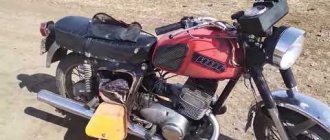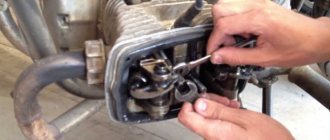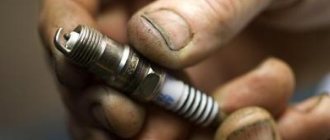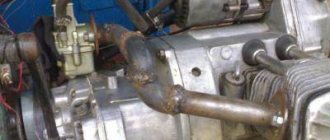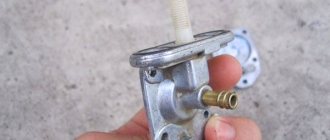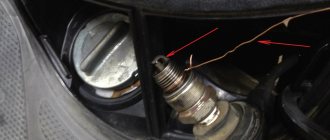The scooter does not start, there is a spark, but gasoline is flowing - what to do to fix it. We diagnose faults in the field with our own hands and mind.
So, no matter what kind of scooter you have, 2T (two-stroke) or 4T, you need to first remove the spark plug. However, you have already done this, since you checked that there is a spark. If the spark plug is wet, let it dry; if it is dry, then gasoline still does not flow into the chamber. This could be due to the carburetor, or due to problems with the timing belt and valves (if you have a 4T). It happens that the sprocket on Chinese scooters jumps by 1 tooth. But, before looking at the marks and getting into the timing belt, check the reed valve.
Petal - also vacuum, usually located under the gas tank. Create a vacuum through the tube from the carburetor - gasoline should flow. If it does not flow, then change the valve, or simply pierce the membrane with a wire and plug the vacuum hose with a stick.
If there is compression, then you need to look at the carburetor and valve mechanism. Naturally, the carburetor breaks down more often. You can again look at the symptoms by looking at the candle - if it’s white, then there was a deficiency of the mixture, if it’s black, it’s over-enriched. Check the air filter or temporarily remove the pipe. Try spraying carburetor cleaner. It is not recommended to disassemble it without experience.
Again, it can clarify a lot whether the motor seizes or not. If there are no flashes at all, then most likely it is the timing belt or a burnt-out piston. If there are flashes, then the carburetor.
One thing is good, if the scooter does not start there is a spark, then your generator is fine. By the way, the spark may be weak, it is also better to change the spark plug and check the switch, but usually there are at least flashes in the cylinders.
Why won't my scooter start?
I think everyone has encountered a situation when, after a winter period of inactivity, the scooter does not want to start. But there are a lot of other situations in which the scooter does not start. In this article we will try to find out all the possible reasons why the scooter does not start and we will try to eliminate them. There are several main reasons that can make it difficult to start an engine.
Let's get started. The first reason is the most basic - check whether fuel is entering the carburetor. This can be done by unscrewing the fuel drain screw from the carburetor. If there is no fuel in the carburetor, then check its presence in the gas tank, see if the air access tube into the gas tank is clogged. The fuel filter could become clogged or the vacuum pump could fail. It would also be a good idea to check if the needle in the float chamber is sticking.
If everything is in order with gasoline, then we move on to the second stage - checking the presence and quality of the spark on the spark plug. We unscrew the spark plug, connect the armor wire to it, turn on the ignition, lean its metal part against the engine and, turning the crankshaft, see if there is a spark. If there is no spark or it is very weak, then the problem may be in the spark plug itself - try cleaning or replacing it. Perhaps the ignition switch, generator have failed, or the ignition coil has broken. As a last resort, check the functionality of the ignition switch.
If there is a spark, then you need to check the compression in the cylinder. This can be done using a special pressure gauge or simply by plugging the spark plug hole with your finger and turning the crankshaft. With normal compression, the finger should be moved away by the air flow. Otherwise you have problems with the piston. You will have to disassemble the engine and check the condition of the rings, piston, valves, condition of gaskets and seals (crankshaft) (they should not suck in air).
Often, the engine does not start due to problems with the carburetor. In this situation, remove the carburetor and clean it completely. You need to wash the carburetor in clean gasoline, after which you need to blow out all the channels with compressed air. Also, one of the reasons why the scooter does not start may be that the air-fuel mixture is incorrectly adjusted. Perhaps the mixture is too rich or too lean.
Do not forget to also check the serviceability of the starting enrichment. Remove it and connect it to the battery. after 5-10 minutes its rod should move forward a few millimeters. Carry out the work 30 minutes after removing the enrichment agent.
After checking all the reasons stated above, you must find exactly the reason why the scooter won’t start. Having eliminated it, you can easily start the engine.
Insufficient fuel
Fuel may not flow due to a jammed carburetor shut-off needle. This is possible when it is clogged, or because the level in the float chamber is out of whack. It is necessary to disassemble the carburetor, blow out all channels and jets with compressed air. You can use a bicycle pump for this. After cleaning, check that the float and the rubber seal on the shut-off needle are intact, and adjust the floats. The position of the floats must be horizontal. Otherwise, by bending the tongue under the locking needle, achieve a horizontal position of the floats on the inverted carburetor. After putting it back together, use a transparent hose to accurately check the fuel level. You can use the VAZ washer hose. by connecting it to the carburetor sump and unscrewing the drain screw, the fuel level should be level with the joint of the bottom cover +/- 2mm as in the figure below:
By the way, if the scooter does not start in the cold, in the morning, or in the fall, then the solenoid enrichment valve is most likely faulty.
Chinese scooter lovers club
Chinese scooter lovers club forum
Time zone: UTC + 3 hours [Summer Time]
Forum Rules
If your question concerns a malfunction of your scooter, or you have any difficulties with operation or tuning, first indicate: Model and manufacturer of the scooter: Engine model: Engine stroke and estimated volume: After that, explain the essence of the problem. Don’t forget, the title of the post should reflect the essence of the problem as closely as possible.
Main reasons
So, let’s look at why the 4t scooter won’t start – the reasons can be roughly divided into the following categories:
- fuel system malfunctions
- ignition system malfunctions
- piston group malfunctions
- malfunction of the gas distribution mechanism (GRM).
Each of these 4 categories has its own several possible causes. When diagnosing a scooter, you should carefully pay attention to each category and the problem in it. Step by step, eliminating faults, you will definitely find the cause. And then it’s a matter of technology!
Advice! Remember that there may be several reasons. Therefore, having eliminated one breakdown, you should still check the serviceability of other devices from the list of possible faults.
Fuel system malfunctions
If there is no gasoline in the tank, the scooter will not start - everyone knows. The same situation occurs when the fuel system malfunctions - gasoline does not reach the combustion chamber. The consequence is that there is nothing to burn, so the engine does not start. The reasons may be as follows:
- faulty fuel valve
- clogged fuel filter
- contaminated carburetor, failure of its individual parts
- The vacuum suction supplied to the fuel tap does not work.
Tap
It is recommended to start repairs with the simplest ones. In this case, the diagnosis begins with the fuel tap (if there is gasoline in the tank). To check operation, remove the fuel supply hose from the carburetor, then crank the engine with the starter or crank. The serviceability of the tap will be visible by the stream of gasoline flowing from the hose.
The first thing you need to do is make sure there is gasoline in the fuel tank by opening the gas tank cap and looking inside
To make sure that the fuel tap of the scooter is working properly, you should disconnect the gasoline supply hose from the carburetor and, after cranking the engine, make sure that gasoline is flowing from the hose in a stream (observe fire safety measures!)
A constant flow of fuel, even when the engine is stopped, or a lack of fuel supply through the hose indicates a breakdown of the fuel valve. If fuel is constantly leaking, change the valve immediately. Otherwise, you should pay attention to the condition of the fuel hoses, and only then replace the fuel tap.
Filter
The serviceability of the filter is diagnosed visually and by blowing. A dirty filter should be replaced immediately. If the filter looks clean, but does not blow in the desired direction, it means it is clogged and requires replacement.
Carburetor
A dirty carburetor is another reason why fuel does not reach the combustion chamber. The device becomes dirty due to poor filters (fuel and air) and poor fuel quality. Here is a list of actions necessary to eliminate carburetor malfunction:
- remove the carburetor and disassemble it
- rinse and blow out the holes with compressed air (if compressed air is not available, use a regular pump)
- pay attention to the condition of the float chamber, both the float itself and its adjustment; condition of the locking needle - is it worn out or sunk?
- Clean the fuel nozzle thoroughly.
Remember! There are no small details in carburetor repair! One missed moment may cost you to clean the entire carburetor again and find out the cause.
Ignition system malfunctions
Another possible reason why the engine does not work is a malfunction of the ignition system. This group includes many different little things, each of which can become the main reason for the engine not starting.
- dirty or faulty spark plug
- high voltage wire
- ignition coil
- faulty ignition sensor
- failed switch.
Spark plug
Let's start our search again with the simplest thing. Unscrew the spark plug from the cylinder, put a cap on it and lean the electrodes against the cylinder. Next, rotate the engine with the starter. In this case, a spark should jump between the two electrodes of the spark plug - straight and curved. If it is missing, you should perform a number of actions:
- Clean the spark plug from carbon deposits and oil contaminants using a rag and a metal brush
- warm the candle on the fire of a gas burner
- set the optimal gap between the electrodes - the gap should be about 1-1.5 mm.
After completing these steps, check for spark again. If it appears, then you can try to start the engine. If there is no spark, replace the spark plug with a new one. If there is no spark on the new spark plug, you should pay attention to deeper problems.
To check the spark in the spark plug, lean it against the metal frame (engine) and turn the engine
High voltage wire
The most common problem with a wire is its exposure in a certain place (broken wire). A working wire should spark off the cylinder body or other metal part of the engine when the tip is removed.
If it’s not scary, you can check for voltage with your finger, but it’s better to rest it against the engine. A broken wire will conduct electricity at the break point without reaching the spark plug. The exposed area should be insulated or the wire replaced with a new one.
You can check the high-voltage wire using a special indicator screwdriver
Ignition coil
To test the ignition coil, you need a device for measuring electrical quantities - a multimeter. Disconnect the coil from the scooter: remove the tip of the wire from the spark plug, unscrew the bolt securing the coil and disconnect its contacts.
Using a multimeter, measure the resistance at the coil contacts. Also measure the resistance between the contacts and the spark plug output. The optimal values for the coils of different scooters can be found by the model of the scooter. For example, the optimal resistance of the primary winding of the ignition coil on a Honda Dio scooter is 0.2-0.3 Ohm; secondary winding - 8.2-9.3 kOhm.
Checking with a multimeter
Piston group malfunctions
Having an insufficient degree of air compression in the engine cylinder, the scooter starts poorly or does not start at all. Experienced scooter riders can immediately determine the approximate compression level. A conclusion about the value of compression can be made by trying to start the moped with a kick starter.
When more effort is required in a certain position, it means compression is present. If the leg does not provide resistance, then the necessary pressure is not created in the cylinder. To be more sure, you should use a compression gauge.
Unscrew the spark plug from the cylinder and insert the tip of the device there. Rotate the engine with the starter. The compression meter will show the exact value of the compression ratio. The optimal compression value is 10 kg/cm2. If the compression in the engine is less than 7 kg/cm2, the piston should be repaired or replaced.
Checking with a compression gauge
Timing faults
You don’t need to read this paragraph if you have a 2-stroke scooter, because such engines do not have a timing belt. The cause of a timing belt malfunction may be carbon deposits on the valves or improper adjustment.
This is what the gas distribution mechanism (GRM) of a scooter looks like
You can check the air leak by placing your hand against the air filter hole on the carburetor. You should feel the creation of a vacuum with your hand. You can attach a plastic bag to the hole and rotate the engine - the bag should be pulled inside the carburetor and tear.
Check using a plastic bag placed over the neck
If this does not happen, it is recommended to get to the timing mechanism and repair it. If necessary, cleaning should be done.
Article “scooter won’t start”
It may not start 1 - if the spark plug is broken (damp, sooted, faulty), the spark is not in time (the wires from the sensor are turned over on 2t it can start in the other direction, on 4t 1 wire cannot be turned over), the rotor is not tightened or the rotor key is turned , the stator is unscrewed, the commutator is faulty, but there is a spark, a weak spark is due to a breakdown or interturn short circuit in the ignition coil, in the ignition windings, the battery is discharged (DC SDI), the resistance in the cap has burned out, breakdown of the cap, coil and explosive wires to the housing , the alarm system is faulty (it is better to turn it off during the test), the brake was not pressed, and the side stand was not removed. 2t in such cases it is better to start the revs higher with kick, for 4t XZ, combine battery. 2- poor compression: wear of the rings or cylinder (large gap in the ring locks for 50cc 0.15-0.25, for cubic capacity 0.2-0.35), burnt rings (no longer springy), rotated rings (4t, locks come together) , spread at an angle of 120 degrees, all rings), stuck rings (they don’t come out of the grooves well, coke, remove and clean the grooves), large scratches and grooves on the piston and cylinder (replace the cylinder head), leaking valves, stuck valves due to a bent valve stem and breakdown of the gasket under the head (such as a slapping knock). Checking the compression. 3 - low-quality fuel, change it, drain the old one from the carburetor, fill the float chamber with new one, restart the engine, start it. 4 - lean starting mixture (the spark plug is dry, it may seize, but will not start), fuel does not flow well into the carburetor, the starting enrichment is stuck closed (very rare), the jets are clogged, including the enrichment, air is leaking through a leaky pipe (manifold), crankshaft oil seals for 2t are torn or do not hold well, fuel does not flow well from the tank to the carburetor (the filter is clogged, the vacuum valve is faulty, the hoses are looped upward), the filter element is installed crookedly in the air filter, air passes in addition to the filter element, the filter is dry (rinse and soak ) 5 - rich mixture, the spark plug is immediately filled in after 3-5 kicks, the float shut-off needle is clogged, the vacuum valve is faulty, fuel is sucked into the engine through the vacuum hose, the jet has been unscrewed, the air filter pipe has closed the air channels of the main system (at 2t). 6-4t the timing chain has jumped, the valve timing is incorrect. We check the correct installation by the mark on the rotor, TDC and camshaft position. 7- There are also cases when the weights get lost in the varicose, the engine is immediately loaded with a wheel and it is difficult to bring it in.
This is interesting: Experts have named the speed that is fatal for drivers during an accident
And crazy malfunctions like: I didn’t pump gasoline into the float chamber and start it, didn’t connect the air vent, forgot to put on the cap, connect the wires, turn on the ignition. Disarm alarm, etc. It's up to you.
First, you need to create easy starting conditions: put it on the center stand, turn on the headlights (when it’s off, the resistor works, when the headlights are on, they can take a lot on themselves), the lightest dimensions on the engine.
Ways to start the engine It won’t start, we quickly figure out why, if it’s cold, we plug the air filter and start it, we don’t turn up the gas to 2t, since the XX + enricher setting should ensure a normal starting mixture at XX (at XX the starting mixture is normal, with gas already lean 2t or rich 4t, so a cold engine starts better without gas, and a hot one with gas booster for 2t, 4t vice versa), it doesn’t help, unscrew the spark plug, check the spark, if the spark plug is dry, check the flow of fuel into the float chamber, if necessary, remove the vacuum hose, suck in and look on a car filter or a transparent hose, gasoline began to flow into the carburetor; for better filling, repeat the operation 3-4 times (it helped to fill more, starting a cold engine more confidently). If the spark plug is damp, check the spark, there is a spark, install a new working spark plug with a smaller gap, start it, it won’t start, turn the gas all the way to 2 tons and try to start it and do the rest of the G, after pumping 5-10 kicks (maybe it starts to seize), let off the gas, start it. If everything starts fine. It won’t start, change the fuel, drain the sediment from the float, do the rest, change the spark plug, start it. It won’t start, at 2t we check the crankshaft seals, suction through the intake manifold (pipe). For 4t pipe, timing, valve adjustment, compression. It won't start when it's hot, full throttle and start 2t. 4t just remove the air filter or remove the vacuum hose, drain the sediment, do the rest, replace the hose and start it. It works unsteadily, we try to de-gas it, then we determine if it stalls at idle or the speed fluctuates, we look for air leaks, it works hard and there are interruptions in the operation of the engine, we look for the cause of the overflow. We check for misfires and change the spark plug. And once again, 2t starts better with a kick, 4t, as suggested below, with a well-charged battery, better with a car battery. Good luck to all!
Last edited by funix on Dec 08, 2010 11:16 pm, edited 2 times in total.
Why is there no spark?
The second most common problem is why the scooter won’t start - there is nothing to ignite the fuel, or there is a spark - but there is nothing to ignite. To check the spark, you need to remove the spark plug cap and unscrew the spark plug. It must be dry and clean. The gap between the electrodes is needed 0.6-0.7 mm. The first sign of a lack of spark is that the spark plug is wet and smells of gasoline. This means the fuel did not burn in the cylinder and remained on the spark plug. Dry and clean it, then insert it into the cap and lean it against the cylinder mass.
At the same time, press the starter button for a second or the kick starter a couple of times. The spark between the spark plug electrodes should be clearly visible. If there is no spark, then replace the spark plug with a new one, most often this is the problem.
You may be interested in how to adjust the ignition on Ural motorcycles or install electronic ignition on Izh Jupiter 5 yourself.
The quality of gasoline in Russia is not very good, this quickly kills spark plugs, especially iridium ones. If a spark does not appear with the new spark plug, we look for a fault in the wiring. A broken wire or oxidation connecting the ground between the frame and the engine is a common problem. Another reason could be a burnt-out resistor in the spark plug cap. It can be checked with a multimeter; the resistance should be about 5 kOhm. If this is not the problem, then check the ignition coil, this can also be done with a multimeter. In this case, the resistance of the primary and secondary windings is checked. The resistance of the primary winding, as a rule, tends to zero. Well, the resistance of the secondary should be several kOhms. There shouldn't be a break.
It is also worth checking the switch by replacing it with a known good one.
The next possible malfunction is a break in the wire coming from the ignition switch or the wire coming from the switch. Check the wires for breaks or abrasions. Check the reliability of the female-male plug connections. If no visible damage is found, a wire break can be detected by testing each wire with a multimeter. If the above manipulations did not produce results and a spark never appeared, the last reason for its absence is failure of the generator, pulse sensor or generator windings, which happens extremely rarely. The generator windings can also be checked with a multimeter.
Principle of operation
Why won't my scooter start? There can be many reasons for this - from a small malfunction of the engine to a serious breakdown.
A moped differs from other types of vehicles in that it is an economical mode of transport. A typical average scooter has a 50cc engine, which is unable to burn too much fuel while driving. This explains the fact why it cannot reach very high speeds. The maximum he can do is move at a speed of no more than 60 kilometers per hour. At the same time, the safety of the moped driver is at risk, since no side safety bars are provided here, as on full-fledged motorcycles. But the reliability and simplicity of the design of this relatively cheap vehicle are so convenient for everyday use that the scooter has always been, is and will be popular among the people.
But even the most unpretentious equipment sooner or later begins to act up and let down its owners. And then one fine day you are faced with the fact that the scooter will not start. This may be due to careless handling, lack of timely technical inspection, as well as objective extraneous causes, consequences of an accident, and the like.
If the moped is not
Sometimes it happens that the moped does not want to start after several hours of inactivity. However, after warming up, it works and starts stably. Let's figure out why this happens.
When the engine is cold, all clearances (in the piston, in the valves, etc.) are far from ideal. Plus, when fuel gets on cold engine parts, it evaporates worse and therefore ignites worse. Because of this, during a cold start the engine needs a richer mixture than usual. It is for this purpose that devices are made on carburetor engines to enrich the mixture at start-up.
On the Alpha moped (and similar ones), an air damper is installed. It reduces the air flow and thereby enriches the working mixture. The damper has two positions: “closed” - the lever is raised up, “open” - the lever is lowered down. When starting “on a cold” air damper must be closed (lift the lever up) . When the engine runs for a while with the throttle closed, it needs to be opened. Driving with the throttle closed will lead to increased fuel consumption and the formation of carbon deposits on the spark plug and piston.
What to do if a cold moped does not start even with the throttle closed? Try using a syringe to fill in 5-7 ml. gasoline directly into the carburetor inlet pipe. If the moped starts after this, then the carburetor needs to be adjusted. If it doesn’t start, check the spark and compression (see above).
Probable causes of breakdowns
Why won't my scooter start? There may be a variety of reasons for this. You take it to the track to start and go to work or for a walk, but the starter does not respond. The scooter often has trouble starting after an accident or a long period of inactivity.
Possible reasons for engine silence may be the following:
— battery discharge; — breakdown of the fuel distribution mechanism; — soot getting on the spark plug; — curvature and deformation of the belt in the motor design; — wear of the piston in the engine, wear of its components.
Each of these reasons requires careful consideration in order to solve the problem. The scooter sometimes does not start due to a manufacturing defect. In this case, repairs will be pointless, because they will take a lot of time and require money.
How to restore starting from the starter
The moped does not start well from the starter, however, doing it from the foot is simple and easy. If the engine does not start well from the starter, you must first check the fuse located in the battery compartment.
The location of the fuse on the battery is marked with an arrow.
Due to the often poor quality of the manufacture of the fuses, and, consequently, the entire starter, the wire located inside the starter glass bulb can barely touch the contact caps, which is why the fuse contact becomes unsuitable. After the low-quality fuse has been replaced, the moped can be started using the starter.
Solutions
This problem can be resolved in two ways. For example, use the kick starter located on the left side near the engine. Pressing it will activate the remaining energy in the generator, and this small dose of energy will start the battery. This charge will not last long, but will allow you to get to the nearest place to charge. The generator's armature and brushes store enough energy to revive the battery. But this is not the only way to “save” the battery:
- if the scooter does not start (there is a spark, there is gasoline), just charge the battery for several hours. The current level should be similar to that in the battery. Otherwise there is a risk of the battery burning out.
We check whether gasoline enters the combustion chamber.
In order to determine whether gasoline is entering the combustion chamber of the engine, you need to look at the spark plug; if the electrode is dry, there is a spark and the scooter does not start, this means that the air-fuel mixture is not entering the combustion chamber. This could be for several reasons,
The vacuum valve that opens the supply of gasoline to the carburetor when the engine starts to rotate does not work
fuel filter clogged
there is no compression, and therefore no fuel is drawn in
The timing belt is not working correctly
In order to check whether the gasoline supply vacuum valve (faucet) is working correctly, you need to remove the hose that goes to the carburetor and try to start it,
if the faucet works normally, gasoline should flow from it while you turn the starter or crank the kickstarter - when the piston descends along the hose that goes from the engine to the faucet, a vacuum is created and the faucet opens. If the faucet does not work, then we try to put the hose straight from the tank to the carburetor, and if the scooter starts up after that, we replace the faucet.
We check the filter to see if it allows fuel to enter the carburetor. If it is dirty, replace it immediately. If gasoline reaches the carburetor normally, then remove and clean the carburetor
If the 4T scooter does not start after cleaning the carburetor, proceed to the next diagnostic step.
Problem with flammable composition
If the scooter does not start, there is a spark, there is gas, but there is no movement, this is a very serious breakdown. It has a working starter, but nothing helps? Perhaps the problem lies in the fuel distribution mechanism. It is better not to repair such breakdowns with your own hands - the hands and eyes of specialists are needed here.
If you have money, it is better to send the scooter to a service station. There is special equipment that can be used to re-flash the built-in injector chip (if it is not a carburetor engine).
Malfunctions in the power system
If there is a spark, but after that the scooter does not start, there is a high probability that fuel is not supplied. To address this issue, start checking at the gas tank. It is advisable if the gas tank is at least half full. To ensure that fuel is supplied to the carburetor, remove the fuel hose from the carburetor by lowering it into a previously prepared container (bottle).
Are all settings normal? But why won't the alpha moped start? See all possible faults!
As a rule, scooters have a built-in vacuum gas valve that opens the fuel supply only during startup or operation of the scooter. To check the valve with the fuel hose lowered into the bottle, we try to start the engine for 3-5 seconds, or until a stream of gasoline appears. In this case, the stream must be constant, at least “as big as a match”. If there is gasoline, but does not flow, the gas valve must be replaced.
If it is working, we look for the cause in the carburetor. First, the air filter must be clean. Because if there is a leak at the junction of the carburetor with the intake pipe, air is sucked in there, the mixture becomes too lean and starting the engine will be impossible. Make sure the gaskets between the carburetor are intact. Let's go further, the reason may be in the carburetor itself.
Cleaning the spark plug
The scooter also has trouble starting if soot settles on the spark plug. This is a combustion product that gradually forms on the part due to constant combustion processes in the engine. This situation occurs if the balance in the ratio of oil and gasoline used is disturbed. This is most common in scooters with two-stroke engines.
When the engine is four-stroke, the source of the problem is most likely only in gasoline. It is necessary to use fuel with a higher octane number - from 80 and above. You can clean a candle by burning it. This element is unscrewed from the cylinder and its base is burned in a flame of fire. At the end, this part is wiped with very light sandpaper with fine grit and screwed into place. After all these activities, the moped should begin normal operation.
This is interesting: A legally correct response to a traffic police officer who stopped him for no reason
Checking whether there is compression on the scooter
In order to check whether there is compression on the scooter, we need a device called a compression meter. It is inserted into the place of the spark plug and the crankshaft is turned using a starter or a winding stem. If the compression is below 7, then you need to change the piston. Ideally, the compression should be about 10. If there is no device to measure the compression, then when you try to start the scooter with the winding leg, you should feel the stroke of the piston as it rises in the cylinder, the leg should provide resistance. That is, if you feel the amplitude of the piston stroke with your foot, the leg turns either easier or more difficult, then there is compression, this is of course all superficial, it is best to find someone’s compression gauge and check the compression on the scooter is normal.
The motor belt is damaged
The scooter does not start - there is a spark, there is gas, but there is no reaction. Another source of the problem may lie in a deformed belt in the motor design. This technical element makes a huge number of revolutions during the day. It is located on the same side as the kick starter, under the engine cover.
The belt itself is a consumable replacement element of scooters, so sooner or later it needs to be replaced. It cannot be restored; all you have to do is buy a new one at a motorcycle parts store. When purchasing this spare part, it is recommended to pay attention to the overall diameter of the belt and the thickness of the rubber layer - they must correspond to the model of the scooter and its configuration. Otherwise it will not work on your moped.
Visual inspection
You should always check using the “from simple to complex” . If the moped was working like a clock just yesterday, but today it refuses to start, remember what happened to it during this period of time. Maybe you made changes to the electrical circuit, or adjusted the carburetor, or washed the moped, or did some other work - sometimes this helps to localize the fault. If possible, return everything back.
Before starting the test, carefully inspect the moped. You may notice a torn or exposed wire or some other small thing. Sometimes this helps a lot.
Piston problem
The scooter does not start for this reason. Very often, problems can occur based on wear of the piston complex. An internal combustion engine (two-stroke or four-stroke - it doesn’t matter) consists of several parts: a cylinder, a piston and its pin, as well as piston rings. Worn and worn parts cause the engine to lose power and then break down completely. It is not necessary to buy a new cylinder, since the old version can be restored or bored. It can be made higher than zero. This saves a lot of money.
When replacing it, it is advisable to purchase all components of a new piston in one set. This is necessary so that wear and tear occurs evenly in the future, and not in parts. The piston, like the rings and the pin, must work synchronously. Then the likelihood of your vehicle breaking down will be significantly reduced.
Any breakdown in the case of an inexperienced driver can seem catastrophic, especially if we do not see explainable reasons for what is happening. However, a minimum of knowledge and skills will help to identify the reason that prevents you from starting a scooter and leading a full motorcycle life. Contact a specialist at a car repair shop or try using the recommendations above - any problem can be solved.
Now you can stock up on the information received and figure out in time the reasons why the scooter does not start, and take the necessary measures to resuscitate it on your own in your personal garage or under the supervision of an experienced friend.
So, we have found out the main causes of moped breakdowns and how to fix them yourself. At this point, the main question of the article “why the scooter does not start with the starter” can be considered closed.
Checking whether the timing belt on the scooter works correctly
Sometimes it happens that the gas distribution mechanism does not work correctly, the valves do not open or close at the right time, or the valves are burnt and do not maintain the pressure in the cylinder at the proper level, then the scooter will not be able to start in this case. In order to check whether the timing belt is working correctly, we take the most common disposable clean bag and put it on the air supply pipe going to the carburetor. In the 150 scooter, to do this, you need to open the air filter and place the bag on the tube, tying something around the bag around the perimeter to prevent air leaks.
If the timing belt is working normally, then air should be sucked into the engine through the pipe and the bag should deflate and burst, allowing air to pass normally into the combustion chamber.
In order to more clearly see why a 4t scooter may not start or does not start well, reasons and ways to eliminate them, watch the video on our channel.
4t scooter won't start
Why the scooter does not start with the button - we identify the reasons
A scooter is a practical vehicle, economical and easy to drive. Modern models are reliable and easy to maintain, but various problems may arise during the operation of the scooter.
One of the most common breakdowns is the failure of the scooter to start with the button.
As a rule, at first the scooter starts from the button every other time , and then does not start at all using the electric starter. How to be in this case?
To fix a problem, you need to identify the cause of its occurrence. As practice shows, there can be many such reasons, but there are also quite common ones.
We list the most common reasons and give ways to solve them:
- Fuel sensor malfunction. No matter how trivial it may sound, this happens quite often: the sensor shows that there is still gasoline left in the tank, and the owner of the scooter looks for the cause of the “breakdown” in a completely different place. Therefore, it would not be superfluous to first look into the gas tank and make sure that there is fuel in it.
- The battery is low. This often happens when equipment is idle for a long time. To solve the problem, just charge the battery.
- Old fuel. Many scooter owners face this problem after winter. There seems to be gasoline in the tank, the electric starter seems to be turning, but something is missing to start the engine itself. The cause of this problem may be old gasoline, try draining it and adding fresh fuel.
- There is no spark in the spark plug. To check this version, you need to unscrew the spark plug, apply it to an unpainted part of the engine (for example, to the cylinder), and use the kickstarter to crank the crankshaft. At the same time, you should not neglect precautions: you should not hold the candle with your bare hands. If there is no spark, the spark plug must be cleaned of moisture and carbon deposits, sanded with zero-grit sandpaper and dried. Ideally, the spark should be white.
- Poor contact at the battery terminals - over time they can become covered with oxide, which is a dielectric. To get rid of this problem, just clean the contacts with the same fine sandpaper.
- The fuel tap and/or fuel line is clogged. If gasoline does not flow into the ignition system or is supplied intermittently, the scooter will not start either from the kickstarter or from the button. To fix the problem, these elements of the fuel system need to be cleaned.
- The carburetor is clogged. Difficulty starting the engine, “floating” speed, failures in engine operation - all this indicates that the carburetor needs cleaning. To remove the carburetor, you need to unscrew the inlet pipe and the air filter pipe, disconnect the terminals of the starter enrichment, remove the gasoline supply pipe and drainage. Then you need to disconnect the throttle cable and you can remove the carburetor. Next, you should carefully disassemble the power system assembly, clean it and put it back together. After cleaning the carburetor, do not forget to adjust the floats to a horizontal position!
- No compression. Inspect the piston group. When the piston moves to top dead center, pressure should appear in the cylinder. This can be checked using a special device - a compression meter. To do this, screw the compression gauge fitting in place of the spark plug and turn the crankshaft using the kickstarter. On 2-stroke scooters the compression should be 7-8 kg/cm2, on 4-stroke scooters - 9-10.
We measure compression
Compression is the pressure in the cylinder at the end of the compression stroke. The magnitude of this pressure allows you to assess the condition of the engine. A working Alpha moped engine should have a compression of at least 8-10 kg/cm² (“atmospheres”) . If it is less, then the engine is faulty: either the piston rings are worn out or the valves are leaking. Most likely the engine will need to be disassembled.
Compression is measured using a compression meter - a special pressure gauge that is inserted or screwed in (depending on the design) instead of the spark plug.
Before measuring compression, it is advisable to warm up the engine, but if it does not start, you will have to measure it cold. It is also advisable to unscrew the carburetor or open the throttle valve and turn off the fuel supply.
The engine must be rotated using an electric starter or kickstarter until the compression meter readings stop increasing.
When the compression is less than 8 atmospheres , you need to pour 10-15 ml of engine oil into the spark plug hole using a syringe. If after this the compression increases noticeably, it means the piston rings are worn out . If not, then the problem is in the valves or camshaft drive . The most common reason: the camshaft drive chain is broken or has slipped, or the valves are bent/broken.
Start in the cold
Now let's discuss the situation of starting the engine in the cold. This is a fairly common situation, since we live in not the warmest regions, and many people use their iron horses in the cold season. So, the engine does not start in the cold or stalls immediately, no matter how you try to start it? both electric starter and kickstarter. What to do? Is there a solution to this situation?
First, let's fill up with fresh gasoline. Secondly, let’s replace the oil with synthetic, it thickens somewhat less in the cold than mineral water. Thirdly, try starting in the cold not with an electric starter, but with a kickstarter, since in this case it will be easier for the engine to overcome the difficulties associated with thick oil, stiff belts and gasoline that does not evaporate well in the cold. Also try giving a little more gas than usual when the engine starts. If you did everything correctly, the engine should not stall. If it doesn’t start or stalls immediately, then it may be worth heating the oil with a blowtorch.
If all these conditions are met, the engine should start even at a temperature of minus twenty. Don't forget to let the engine warm up for at least 5-10 minutes after starting. This is a simple starting diagram.
